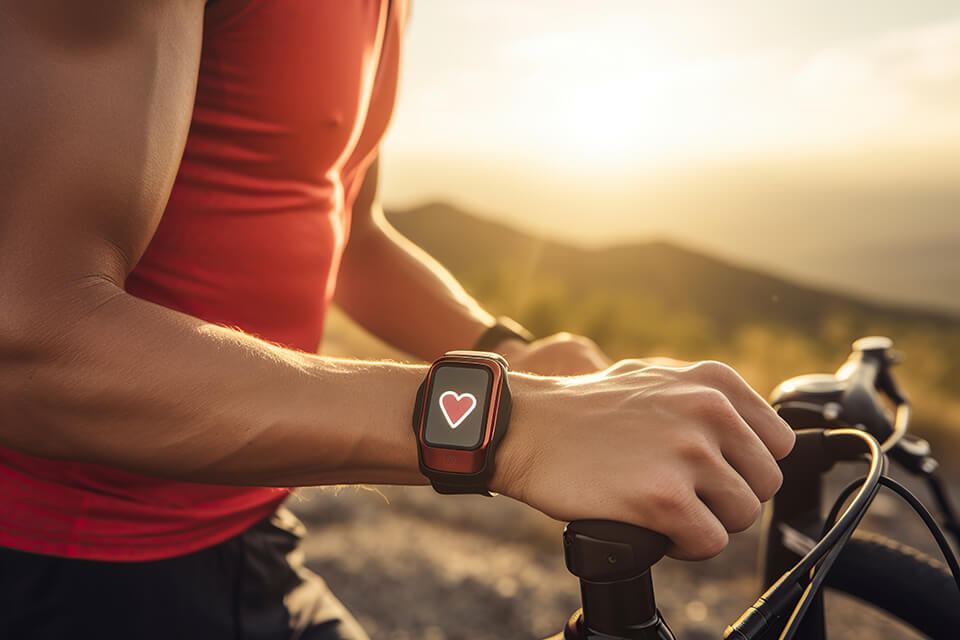Have you ever considered the myriad of health benefits from cycling? Not only is it a fantastic way to explore the world, but it also provides countless physical and mental health advantages for people of all ages. In this blog post, we will delve into the many reasons why cycling should become your go-to activity for a healthier and happier life.
Key Takeaways
- Cycling offers numerous physical and mental health benefits, including improved cardiovascular health, increased muscle strength and endurance, joint mobility, stress reduction and cognitive function.
- Indoor or outdoor cycling can be chosen based on individual preferences with safety guidelines in place for a safe ride.
- Cycling is an accessible activity suitable for all ages that promotes healthy habits while providing physical and mental well-being.
Physical Advantages of Cycling

Cycling is more than just a means of transportation; it is a powerhouse of health benefits. From boosting cardiovascular health to increasing muscle strength and endurance, and even enhancing joint mobility, the benefits of cycling make it an all-in-one solution for a healthier body.
Let’s examine these physical benefits more thoroughly.
Cardiovascular Health
Did you know that cycling on a regular basis can reduce the risk of coronary heart disease by improving blood circulation, lowering high blood pressure, and enhancing the body’s ability to utilize oxygen? Indeed, studies have shown that regular cycling can reduce the risk of heart disease by 50% and the risk of heart attacks by a similar margin.
Making cycling part of your workout routine can contribute greatly to improving your heart’s health and reducing cardiovascular disease risk. Given the multitude of heart health benefits, it’s hardly surprising that many choose cycling to enhance their cardiovascular fitness.
Muscle Strength and Endurance
As an aerobic exercise, cycling engages a wide range of muscles in the body, including:
- Quadriceps
- Core
- Arms
- Shoulders
- Calves
- Hamstrings
With each pedal stroke, you’re targeting different muscle groups in your lower body, helping to build strength and endurance.
Cycling supports balance control by engaging smaller supporting muscles, which aid in maintaining balance. Adding sprint and strength training to your usual exercise regimen can further boost your muscle strength. That’s a full-body workout for you!
Joint Mobility
For those with joint concerns, cycling is an ideal choice as it offers a vigorous workout without straining the joints. As a low-impact exercise, cycling can improve joint mobility by reinforcing the muscles surrounding the joints, reducing the possibility of injury, and heightening overall physical performance. Incorporating cycling into your exercise routine can provide numerous benefits for joint health.
So, hop on your bike and give your joints a break without compromising on an intense workout.
Mental Health Perks from Cycling

Cycling isn’t just about physical health; it also offers a plethora of mental health benefits. From stress reduction and mood enhancement to improved cognitive function, cycling can significantly impact your overall mental well-being.
Let’s delve deeper into these mental health advantages.
Stress Reduction
Regular cycling can help alleviate stress and anxiety by providing an avenue for physical exercise, which can help decrease cortisol levels and promote a positive mood.
Moreover, cycling is known to enhance sleep quality, further aiding in stress and anxiety reduction. So, should you feel stressed or overwhelmed, adding cycling to your fitness regimen might help in calming your mind.
Mood Enhancement
Moderate-intensity cycling has been shown to induce the secretion of endorphins and other mood-enhancing chemicals such as serotonin and dopamine. These natural chemicals released during cycling can contribute to reducing stress and providing a sense of happiness.
Additionally, cycling has been demonstrated to have a positive impact on anxiety and depression, making it a valuable tool for improving mental health.
Cognitive Function
Cycling, especially outdoors, can enhance cognitive function and brain power by promoting the growth of new connections in the brain. Regular cycling can result in superior cognitive function and an improved mood, thereby decreasing stress levels. Engaging in brain power cycling can be a great way to achieve these benefits.
So, not only are you giving your body a workout, but you’re also giving your brain a boost!
Cycling for Weight Loss

If weight loss is your goal, cycling can be a powerful ally in your journey. By burning calories and boosting metabolism, cycling can help you shed those extra pounds and maintain a healthy lifestyle.
Let’s dig deeper into how cycling can facilitate weight loss.
Calorie Burning
The number of calories burned during cycling depends on factors such as:
- Fitness level
- Weight
- Age
- Workout intensity
By engaging in regular cycling, you’re not only giving your body a workout but also burning hundreds of calories in the process.
In fact, cycling burns 50% more calories than walking for the same duration. So, if you’re looking to lose weight, it’s time to pedal your way to a leaner physique.
Metabolism Boost
Regular cycling can help improve your metabolism, which plays a crucial role in sustaining a healthy weight and enhancing general health and well-being. With an improved metabolism, your body becomes more efficient at burning calories and fat, making it easier for you to maintain your weight loss goals.
Therefore, consider adding cycling to your workout routine to enjoy the benefits of a boosted metabolism and improve aerobic capacity.
Cycling and Disease Prevention
Cycling not only helps you maintain a healthy weight, but it can also play a significant role in preventing and managing various diseases, such as type 2 diabetes and certain types of cancer.
Let’s examine in more detail how cycling can aid in disease prevention.
Type 2 Diabetes
Regular cycling can lower risk of developing type 2 diabetes by at least 22% and help manage blood sugar levels in overweight individuals with diabetes.
Furthermore, cycling has been found to increase bone density, thus reducing the risk of fractures in people with type 2 diabetes.
By making cycling a part of your exercise regimen, you’re not just maintaining fitness but also safeguarding yourself from potential health threats.
Cancer Prevention
Cycling has been shown to benefit cancer patients by reducing treatment side effects and may help prevent certain types of cancer. Regular cycling can play a considerable role in reducing the risk of cancer by maintaining the optimal functioning of cells.
In fact, women who cycle regularly experience a 34% reduction in their risk of breast cancer. With such promising results, it’s clear that cycling can be a powerful tool in the fight against cancer.
Indoor vs Outdoor Cycling

Whether you prefer the convenience of indoor cycling or the mental engagement of outdoor cycling, both options offer unique benefits.
Let’s weigh the benefits of indoor and outdoor cycling to assist you in making the right choice.
Convenience and Safety
Indoor cycling provides a convenient solution for those with time limitations or safety considerations, allowing you to exercise in the comfort of your own home and tailor your workout to your individual fitness level.
Additionally, indoor cycling eliminates the potential hazards associated with outdoor cycling, such as traffic, weather conditions, and uneven terrain, providing a safe and controlled environment for your workout.
Balance and Mental Engagement
On the other hand, outdoor cycling offers additional benefits such as improved balance control, mental engagement, and relaxation. Spending time outdoors while cycling can also have a positive effect on brain structure by increasing the production of proteins that are important for learning and memory.
Hence, if you’re in search of a workout that’s both engaging and stimulating, outdoor cycling might just be what you need.
Cycling Safety Tips
No matter your preferred cycling environment, following cycling safety tips is crucial to prevent accidents and injuries.
Let’s go through some key safety guidelines to ensure your ride is both safe and enjoyable.
Helmet and Visibility
Wearing a helmet is essential for cycling safety, as it can significantly reduce the likelihood of sustaining a brain injury. Additionally, ensuring visibility to drivers is crucial. Wear fluorescent colors during the day and reflective colors at night, particularly on your lower body.
By adhering to these precautions, you’re setting yourself up for a secure cycling experience.
Mount and Charge Case
Properly mounting and charging your phone can keep you connected and help prevent accidents. A phone charge case and bike phone mount will keep your phone within view on all your rides and allow you to wirelessly charge it.
Keeping your charge case and bike phone mount in good condition is a vital step towards ensuring a safe and enjoyable ride.
Road Safety Rules
Adhering to road safety rules and being aware of potential hazards is vital for keeping cyclists safe on the road. Be mindful of traffic, pedestrians, animals, and other cyclists, as well as weather conditions and the terrain you’re riding on.
Staying alert and adhering to safety rules ensures a secure and satisfying cycling experience.
Cycling for All Ages
Cycling is a versatile activity that can be enjoyed by people of all ages. From family-friendly outings to health benefits for older adults, cycling offers something for everyone.
Let’s discuss how cycling can be an appropriate and enjoyable activity for all ages.
Family-Friendly Activity
Cycling can be enjoyed by the whole family, promoting healthy habits and providing quality time together. Here are some ways families can bond and stay active together through cycling:
- Cycling games and challenges
- Themed rides, such as costume rides or scavenger hunts
- Bike-centric vacations, exploring new places on two wheels
- Nature rides, enjoying the beauty of parks and trails
These activities offer opportunities for families to have fun, stay fit, and create lasting memories.
So, assemble your family and set off on a cycling journey that everyone will treasure.
Benefits for Older Adults
For older adults, cycling’s low-impact nature offers numerous benefits, such as maintaining muscle strength, balance, and overall health. By engaging in regular cycling, seniors can improve their physical and mental well-being while minimizing joint discomfort or mobility issues.
Hence, irrespective of your age, cycling presents a great option to maintain fitness and health.
Summary
In conclusion, cycling is a versatile and accessible activity that offers numerous physical and mental health benefits for people of all ages. From promoting cardiovascular health and muscle strength to reducing stress and preventing diseases, cycling can be a powerful tool in achieving a healthier and happier life. So, whether you prefer indoor or outdoor cycling, hop on your bike and start reaping the rewards of this fantastic activity today.
Frequently Asked Questions
Can cycling reduce belly fat?
Cycling is an effective way to reduce belly fat, as it has been linked to high blood pressure, high cholesterol, high blood sugar, and diabetes. A 2014 study found that combining cycling with weight training can help prevent age-related gain in belly fat and may also reduce existing fat. Regular cycling at a moderate intensity level will help promote overall fat loss and reduce belly fat over time.
Is 30 minutes of cycling a day enough?
Cycling for 30 minutes a day is an effective way to build up your aerobic capacity and overall muscular endurance. With regular exercise, you can experience the benefits of cycling and achieve a healthy lifestyle.
Which muscles are toned by cycling?
Cycling tones the quadriceps, hamstrings, glutes, calf muscles, abdominals, erector spinae, upper body muscles, calf soleus and gastrocnemius, thighs hamstrings and quadriceps, gluts gluteus maximus, medius, and minimus, arms biceps and triceps, shoulders deltoids, and foot plantar flexors and dorsiflexors.
How can cycling improve cardiovascular health?
Cycling can reduce the risk of coronary heart disease, improve blood circulation, lower blood pressure, and enhance oxygen utilization, thereby improving cardiovascular health.
Can cycling help with weight loss?
Cycling can definitely help with weight loss, as it burns calories and increases your metabolism.




Leave a comment
This site is protected by hCaptcha and the hCaptcha Privacy Policy and Terms of Service apply.